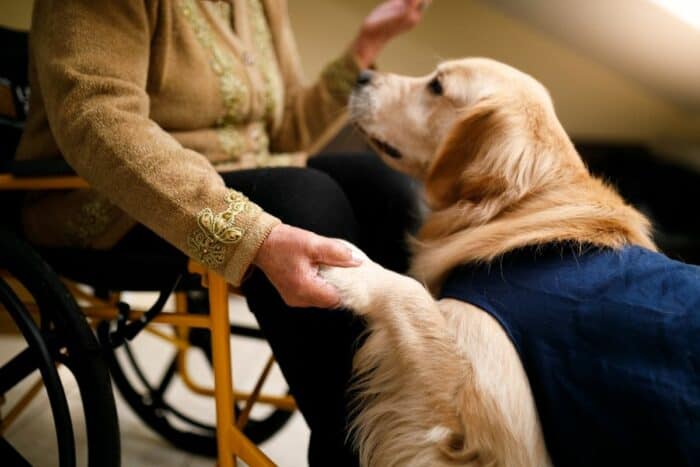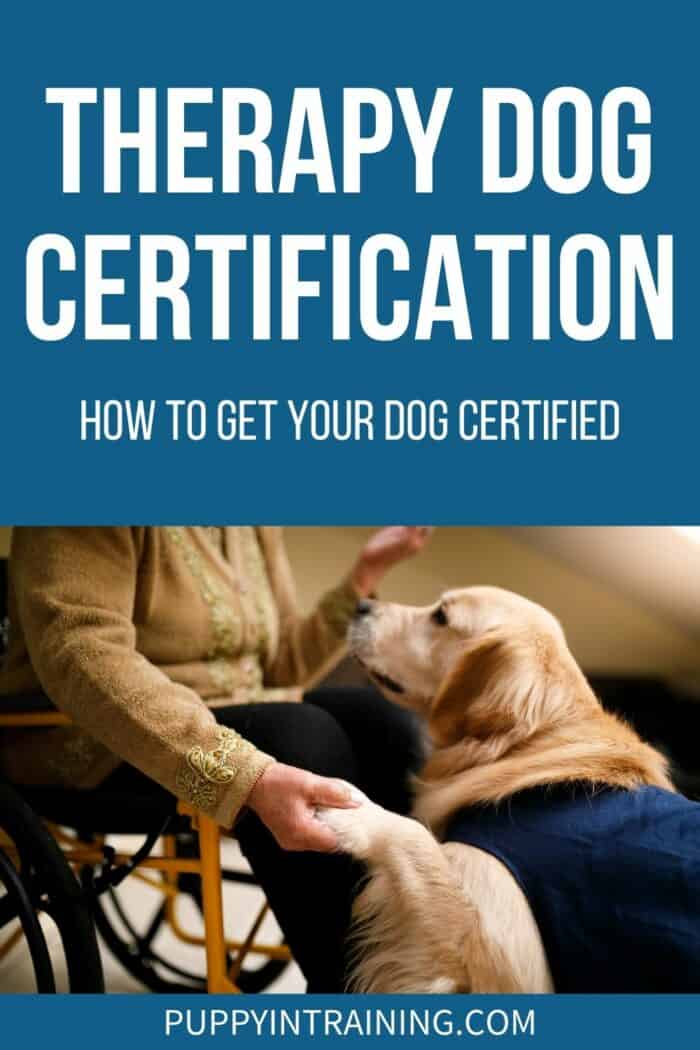How Do I Get My Dog Certified as a Therapy Dog?
This post may contain affiliate links. We may earn money or products from the companies mentioned in this post.
As a dog trainer, people often ask me how their dogs can become certified therapy dogs.
They want to show the world how great their dogs are–as well as help others.
As I’m sure you know from living with your own amazing dog, dogs boost our mood. And they just make every day better.
In order for your dog to be a therapy dog, many requirements must be met.

This article will discuss those requirements and how to meet them.
I did therapy dog work in a hospital for years.
People loved the comfort my dogs provided. And my pups did some tricks to amuse the patients.
Over the years, two of my shih tzus, three of my shelties, and one of my golden retrievers were therapy dogs.
Some were rescued dogs. And the dogs loved it as much as–if not more than–the patients did!
What Is a Therapy Dog?
A therapy dog visits people to provide comfort, increase the well-being, and improve the quality of life of the people and staff that they visit.
They provide affection, comfort, and support to vulnerable people who need it.
When I visited a hospital with my dogs, the staff appreciated it as much as the patients did. They told me that it helped to relieve their stress and brightened their day.
The handler/dog team are generally volunteers and don’t receive any compensation.
Therapy dogs are not service animals. Service animals are trained to provide specific tasks for an individual who has mental or physical disabilities.
Service animals are protected by Federal law and have access to go anywhere.
Therapy dogs provide comfort to certain people but don’t receive training to provide services to any specific individual.
They are not allowed to go everywhere. And they may require certain certifications to go to some facilities.
What are the Benefits of Doing Therapy Dog Work?
Of course, one of the great benefits is a feeling of satisfaction of doing something to benefit others–and your community.
There are also tangible health benefits to the staff and patients you visit.
Interaction with a friendly dog has been shown to help lower a person’s blood pressure and slow their heart rate. It also reduces anxiety.
Stress hormones such as cortisol and dopamine may be better regulated.
The positive interaction with friendly animals also stimulates the production of oxytocin, sometimes called the “happy hormone,” and endorphins.
This boosts one’s mood and makes one more empathetic to others.
The therapy dogs also have health benefits: the rates of endorphins and oxytocin are higher in therapy dogs than they are in pet dogs.
So, volunteering doing therapy work is a win-win for the handler/dog team and the patients and staff who they visit.
Basic Requirements of a Dog and Handler
There are many different registries that can certify your dog is able to meet the requirements for a therapy dog.
Even though registries vary in some of their conditions, most require that a dog and handler meet certain core items.
Requirements for Your Dog
A therapy dog must have a steady temperament. He must be friendly, patient, confident, gentle, healthy, well-groomed, and at ease in even the most trying situations.
They should love contact with people and being petted.
They need to be confident even when surrounded by strangers, noisy and unfamiliar equipment, and other devices such as walkers, wheelchairs, crutches, and canes.
Unfamiliar noises and sights can’t scare them or make them reactive or aggressive. They may have to face noisy equipment and messages over a PA system
The pup may encounter people with various physical and mental disabilities. Some may move or speak erratically.
Therapy dogs must be intelligent and be able to read people’s moods.
The dog must be under the handler’s control at all times.
So even though your dog may be great at home or in your neighborhood, he may not meet those requirements.
There’s nothing wrong with that–all dogs are individuals and may have other interests and abilities.
Not all dogs are cut out for therapy dog work. Even the friendliest dog may find the requirements to be overwhelming.
I’ve had many dogs and, even though they had good temperaments and were well-trained and socialized, some wouldn’t have enjoyed such work.
The dogs who should do–and excel at–therapy dog work must accept and enjoy being petted by strangers. I stress that they must ENJOY such contact.
It’s unfair to make even a sweet dog do such work if he doesn’t enjoy it. A therapy dog must be focused on his task and enjoy the work.
In addition to having a great temperament and extensive socialization, a dog must have certain training to be a therapy dog.
Of course, he should be trained to never jump on anyone or anything such as a counter or cart.
And he should know basic commands such as sit, down, stay, leave it, and heel/loose leash walking.
And he can’t lick or mouthe people.
Therapy dogs must be calm in all settings they face and can’t take food from patients or from trays or counters.
It’s a lot to ask of a dog.
Therapy dogs usually are required to have periodic vet visits to ensure that they’re healthy and have received required vaccinations, including for rabies.
They also should be well-groomed and bathed before visits.
Any breed or mix can be a therapy dog. Generally, a dog should be at least a year old and have lived with the handler’s family for at least six months.
Some breeds may naturally be more likely to be therapy dogs. Because of their innate love of people and of being petted by them and interacting with them, golden retrievers and labs are often seen volunteering their services.
Handler’s Tasks
Handlers of therapy dogs should be friendly and enjoy the environment where they take the dog. Generally, people use their own dogs–not other people’s–as therapy dogs.
Depending where you go, there may be children, older people, ill people, or people with mental or physical disabilities.
In addition to being outgoing and adapting to the environment, the dog’s handler should enjoy the work.
The handler has to ensure that the therapy dog isn’t overworked or stressed. And he must give the dog needed breaks.
Handlers may have to dress in a certain way, such as wearing pants rather than jeans or wearing closed shoes and not sandals.
And they may need to pass a background check and medical tests.
When I volunteered at a hospital, I had to take and pass a test to show that I didn’t have tuberculosis.
Some facilities also require that a handler receive certain vaccinations, such as the flu vaccine.
Where Do Therapy Dogs Visit?
Many places that therapy dogs work require that they have some type of certification. Specific certification organizations will be discussed later.
Therapy dog and handler teams really provide a great service to the community.
The following is a list of some of the most common places where therapy dogs comfort people.
- Hospitals
- Nursing Homes
- Retirement Homes
- Hospice Facilities
- Rehabilitation Centers
- Schools
- Libraries
- College campuses
- Airports
- Disaster areas
- Funeral Homes
- Courtrooms
Therapy dogs provide comfort and solace to people. They may help people feel less lonely. People in some facilities don’t have any other visitors,
They can console people who have just suffered a horrible loss.
Service dogs may also give some people confidence.
Some therapy dogs help children learn to read. Children read to the dogs; they get confidence because dogs aren’t judgmental.
They may give children confidence to testify in a courtroom.
The need for therapy dogs is real.
So if you’re thinking of your dog becoming a therapy dog, it’s advisable to decide what setting you’d like to help in and where your dog would most enjoy working.
If you determined, for example, that you’d like to visit nursing homes, find some near you and contact them.
Some require only that a dog be well-behaved. But many require that a dog obtain some type of certification to work in their facility.
Ask if they require a certification from a specific organization. Also inquire regarding whether they need the services of a therapy dog.
I’ve discovered that there’s a great need for therapy dogs in many settings.
A friend of mine did therapy work at a nursing home with her border collie mix.
The facility was thrilled to have them. And my friend and her dog Buddy loved being there.
Why Certify With a Therapy Dog Organization?
Organizations that certify therapy dogs will test and certify that your dog has the proper temperament and training for the work.
Some will also test your dog in the setting in which you’ll be working. So they will shadow you to determine that you pass their requirements as a therapy team.
That certification will also lend credibility to your dog/handler team.
In addition, many also provide liability insurance should certain matters go wrong.
There are many organizations that you can choose from. It’s important to do your research regarding their requirements.
And first inquire from any facility you want to go to to determine whether they require that you be certified by a particular organization.
Another article posted on one of our sites lists many of the organizations that certify therapy dogs. Click on the link to see them.
Passing the American Kennel Club’s Canine Good Citizen test may be required by some.organizations. It’s a series of 10 behavior and obedience tests.
Some of the main organizations a facility may require for certification are:
- Therapy Dogs International
- Pet Partners
- Love on a Leash
- Bright and Beautiful Therapy Dogs
- Alliance of Therapy Dogs
Costs Involved
Most organizations that certify therapy dogs are non-profit and many of the people working for them are volunteers. So there are fees involved in doing therapy dog work.
There’s a fee to take the various tests and fees to remain certified. Also, there are costs associated with required vet visits, any medical exams, and vaccinations.
Final Thoughts
Therapy dog work is very satisfying and can really help other people.
But there are certain requirements that must be met before you can volunteer with your dog.
The dog must have a great temperament, be well-socialized, love interacting with new people, and be well-trained.
And you, as the handler may also have to pass certain requirements and incur certain costs.
Have you ever done therapy work with your dog or are you thinking of doing so? Please tell us about it in the comment section below.
Save To Pinterest

Top Picks For Our Puppies
- BEST DOG CHEW
We Like: Beef Collagen Sticks - All of our pups love to bite, nip, and chew. We love using Collagen Sticks to help divert these unwanted behaviors. - BEST PUPPY TOY
We Like: Calmeroos Puppy Toy w/ Heartbeat and Heat Packs - Perfect for new puppies. Helps ease anxiety in their new home. - BEST DOG TREATS
We Like: Crazy Dog Train-Me Treats - We use these as our high-value treats for our guide dog puppies. - BEST FRESH DOG FOOD
We Like: The Farmer's Dog - A couple months ago we started feeding Raven fresh dog food and she loves it! Get 50% off your first order of The Farmer's Dog.
Check out more of our favorites on our New Puppy Checklist.
I have a 4-month-old Golden Retriever puppy that I would like to consider for therapy work. I believe there is an evaluation for temperament and would like to know where to start. I live in western Wisconsin.
Thank you!
Gloria Gillette
gloriag100@hotmail.com